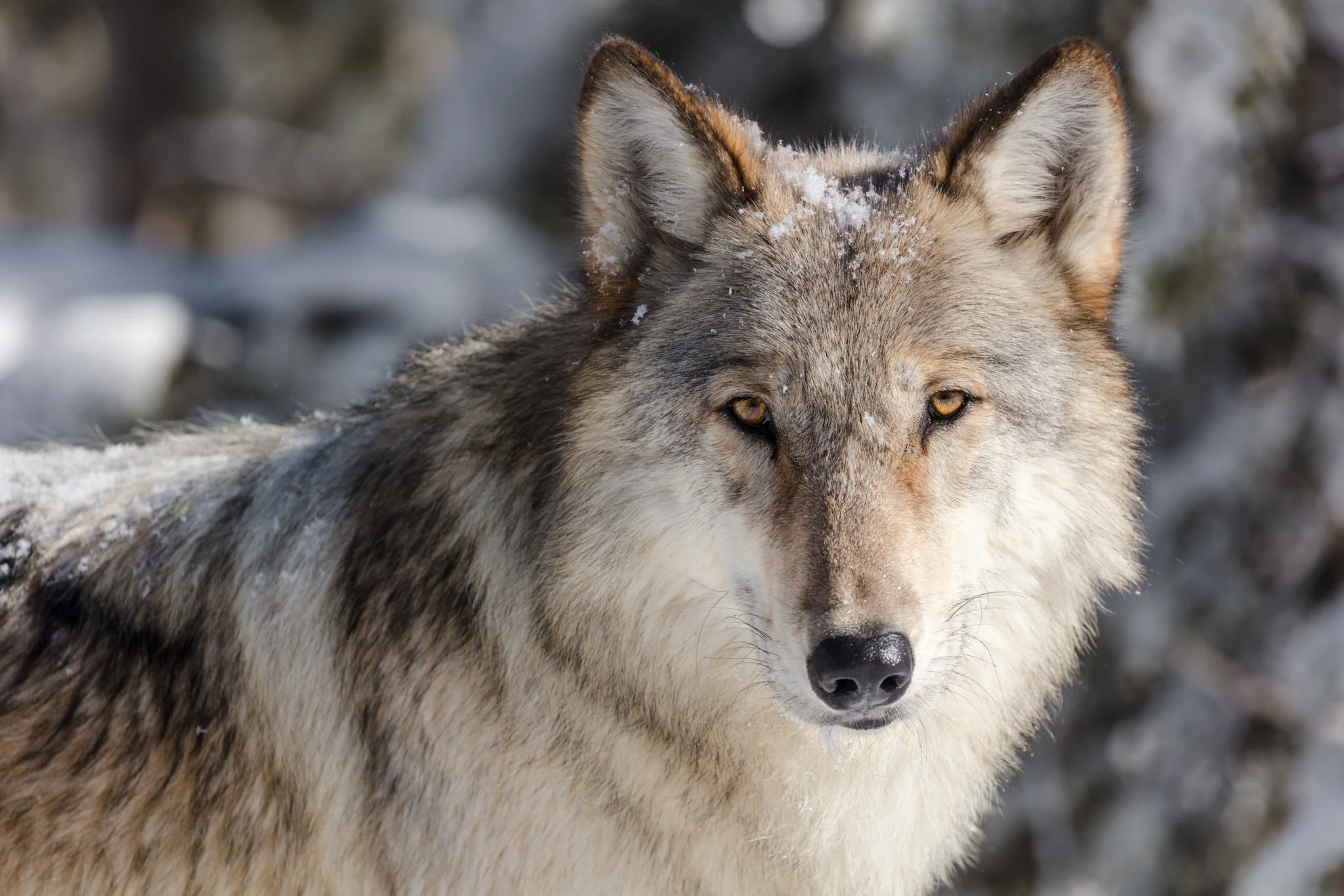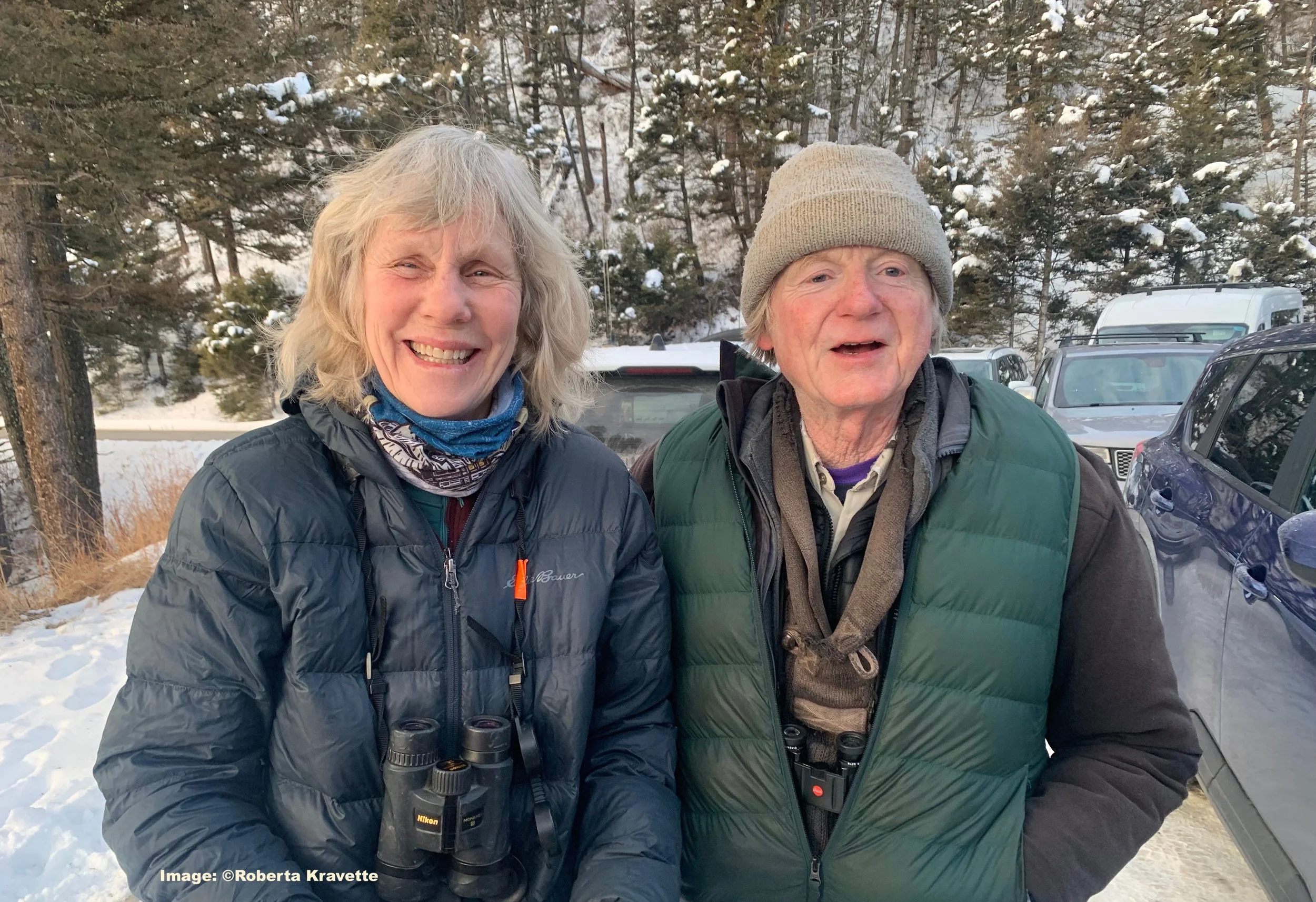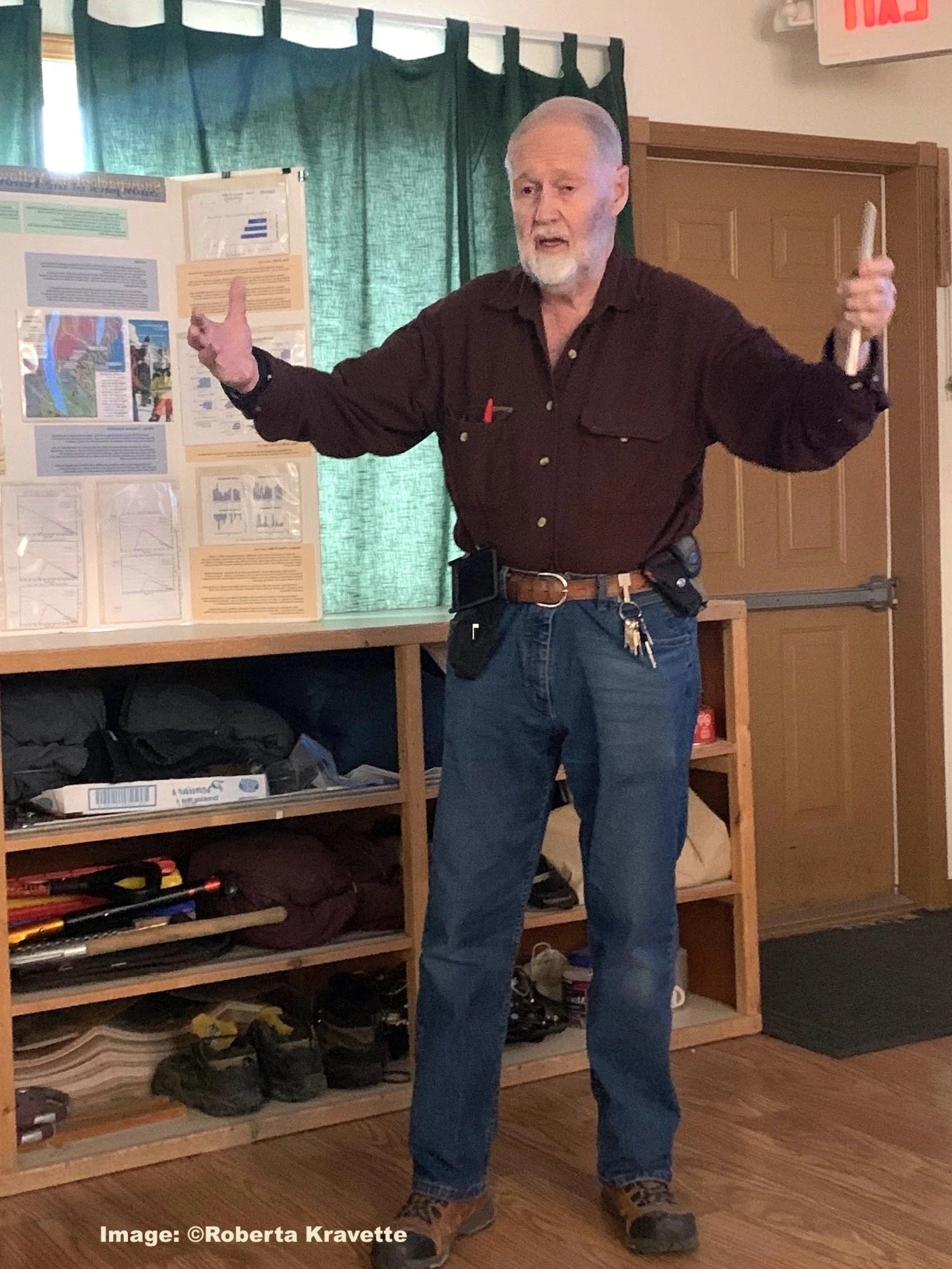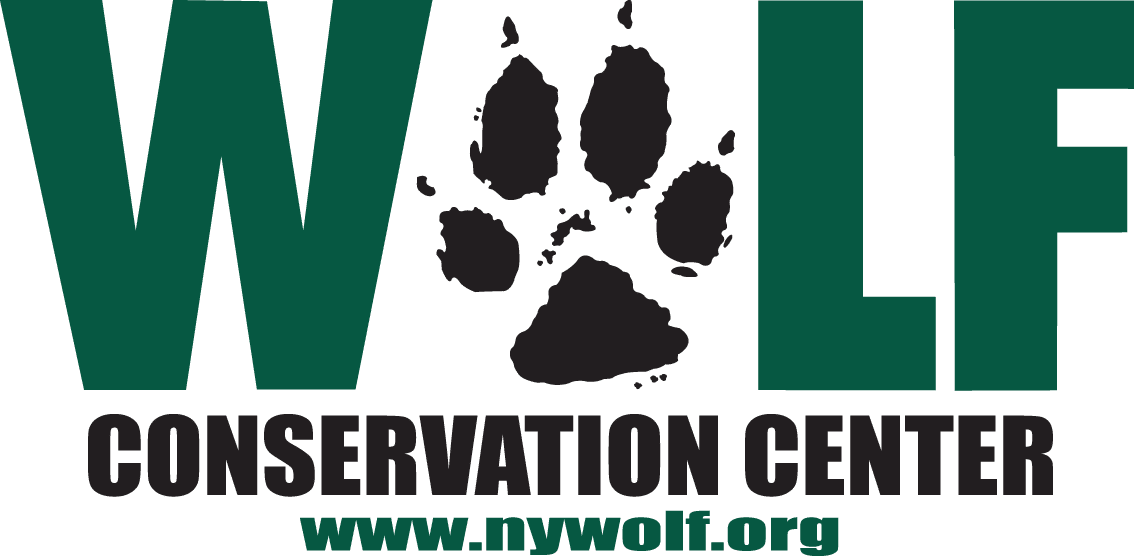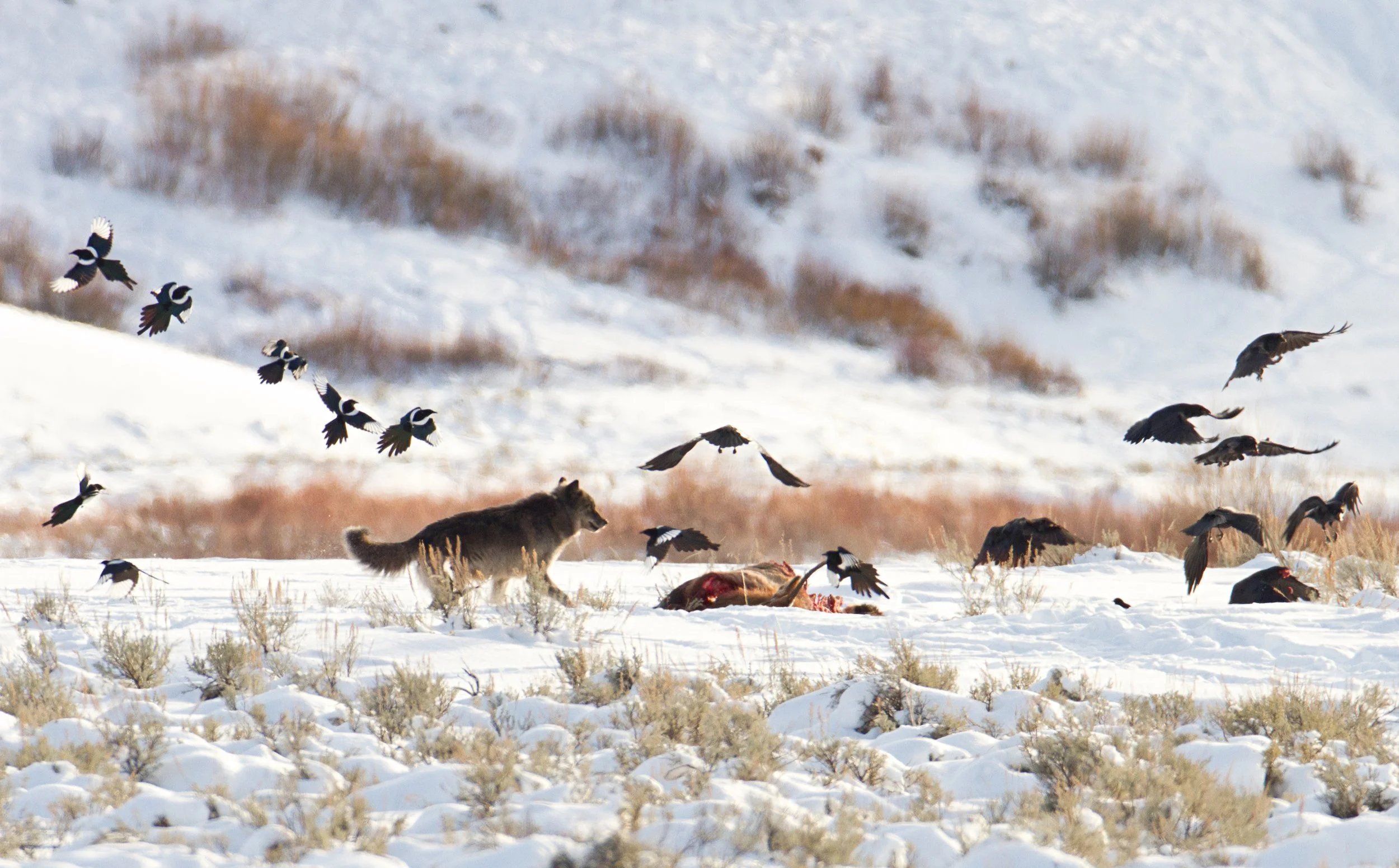Winter Wolf Watching and Learning in Yellowstone
Yellowstone Wolves in Winter
Winter Wolf-Watching & Learning in Yellowstone
To Benefit the Wolf Conservation Center
7 Days - 6 Nights
$6299.00 PP Ex-Flights
$307.00 Single Supplement
Professional wildlife guide
Discover the winter world of Yellowstone’s wolves by day and evening lectures by world-renowned wolf experts,
followed by warm dinners and lively conversation with companions who share your passion for wolves.
Comfortable vehicle; all lodging and meals included.
Limited to 6 Guests each week
2026 Winter Week 1
1 Spot Left
February 22 - 28, 2026
2026 Winter Week 2 -
SOLD OUT!
March 01 - 7, 2026
* Destination: Wildlife donates 10% of the proceeds from your tour to
The Wolf Conservation Center in YOUR name
Why This Tour is Special
This wolf in Yellowstone was unbothered by the snowfall or our presence watching from the roadside. Video thanks to Cara McGary of In Our Nature.
Passionate about Wolves? Discover the wolves’ winter world with a small group of wolf lovers from all corners of the world, sharing once-in-a-lifetime experiences by day and unforgettable stories over warm, cozy dinners.
The Wolf Conservation Center in South Salem, New York, directly benefits from your trip, each ticket includes a $500 donation to the WCC in your name - you receive the tax receipt.
Expand your knowledge and understanding of wolves. This tour offers more than just a chance to see wolves in the wild. Winter in Yellowstone is when passionate scientists, researchers, and documentarians from all over the world come to watch and study this unique population of wild wolves; you will be among them. Each evening our group will meet with an expert in the field to hear about their studies and research.
Your guide is a respected biologist who will share information and answer questions throughout our tour.
Chance encounters in the field with some of the world's premier wolf researchers, documentarians, and storytellers are possible. During past winter wolf trips, we have rubbed shoulders with members of the Yellowstone Wolf Project and university study teams, celebrated wildlife photographers and filmmakers, and enjoyed ad hoc stories on the mountain by the legendary Rick McIntyre. We never know who we will meet on the mountain!
Yellowstone in the winter is a magical place with few tourists, incredible scenery, and better chances to see the iconic wolves. It is something to remember for the rest of your life.
This is responsible tourism at work. Your travel dollars will stay in the local community. Local business owners provide the lodging and meals, and the economic benefits of the trip remain in the community, helping build the case that the Yellowstone wolves are worth more alive than as hunting trophies – in every season.
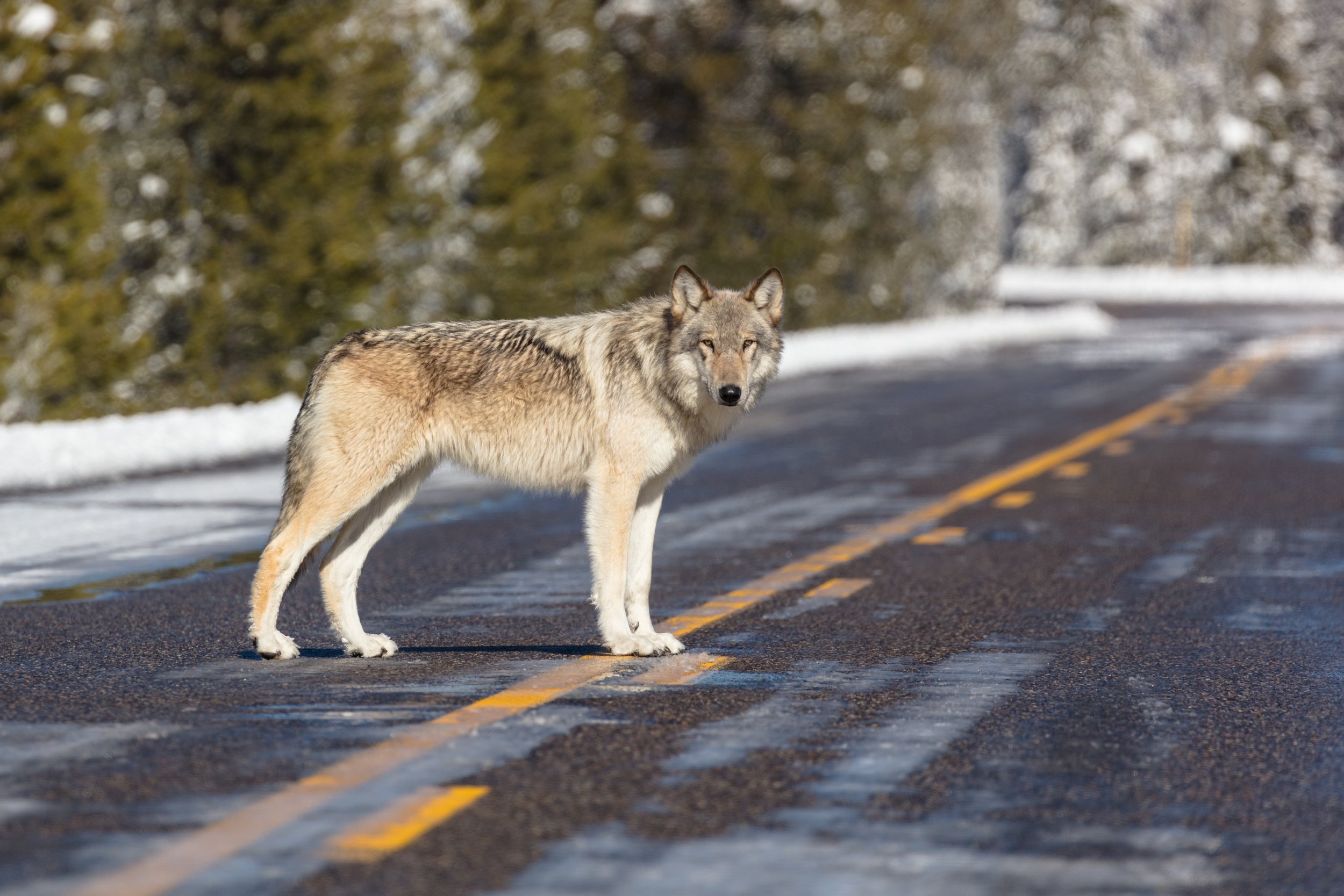
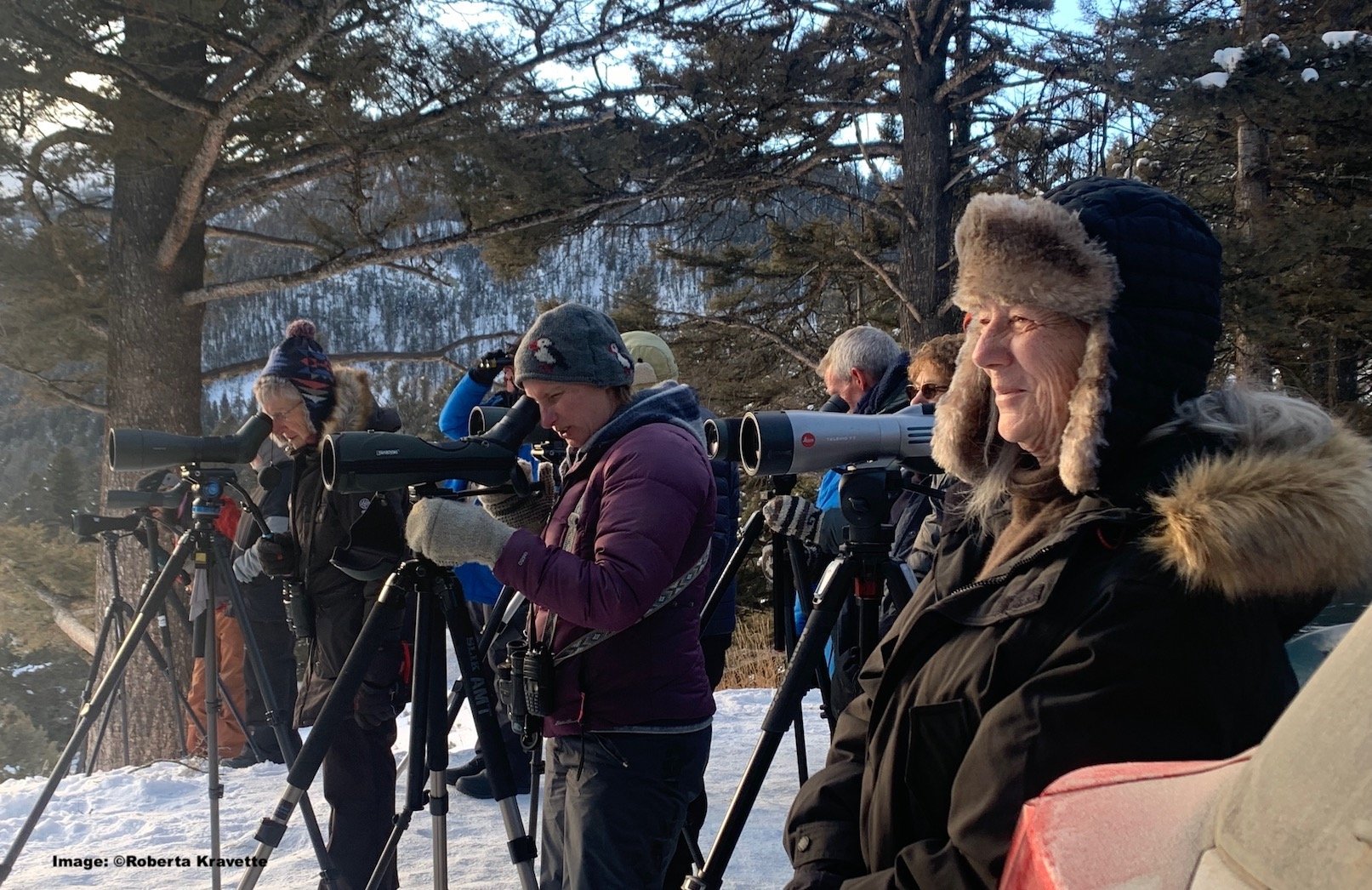
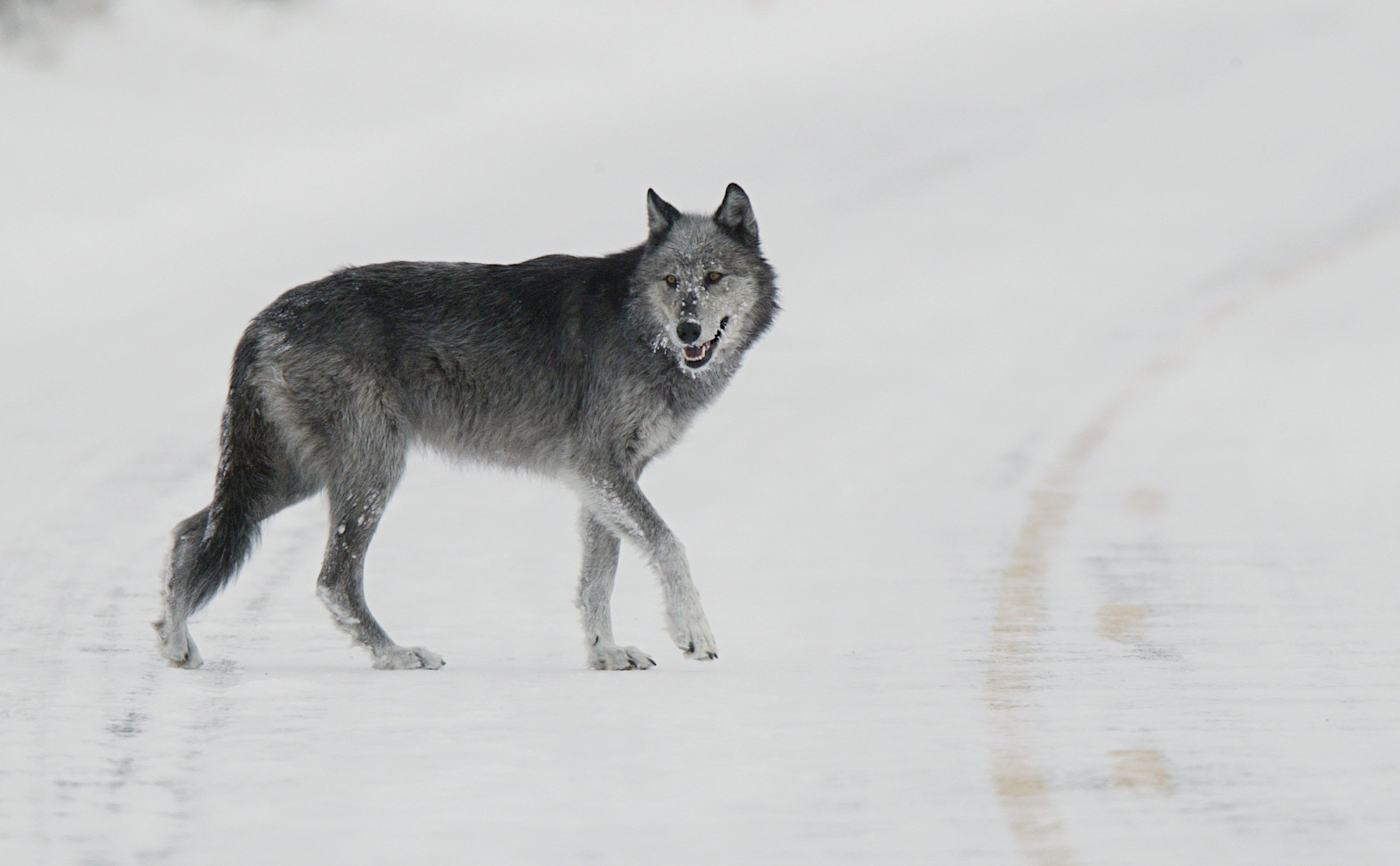
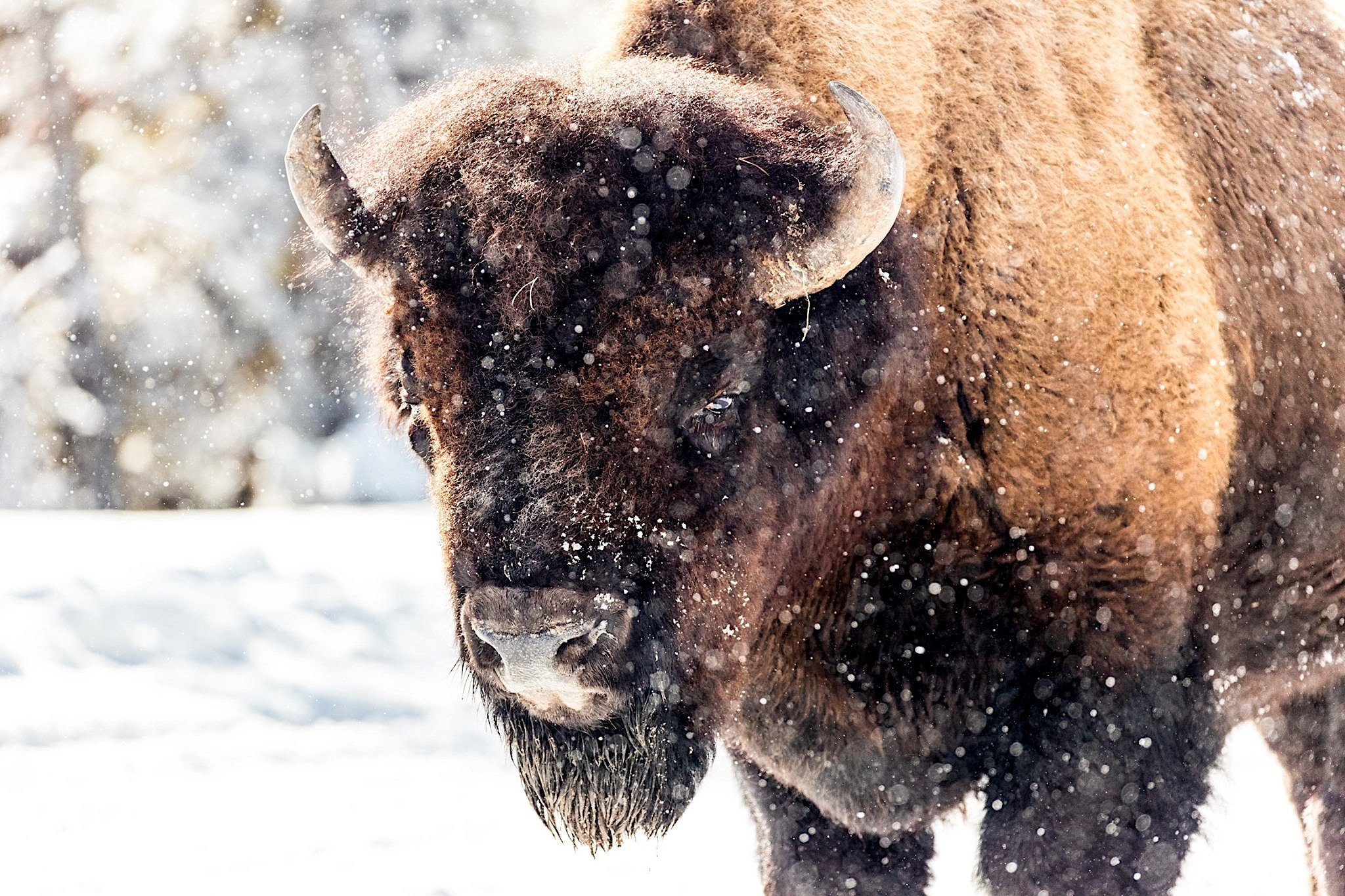
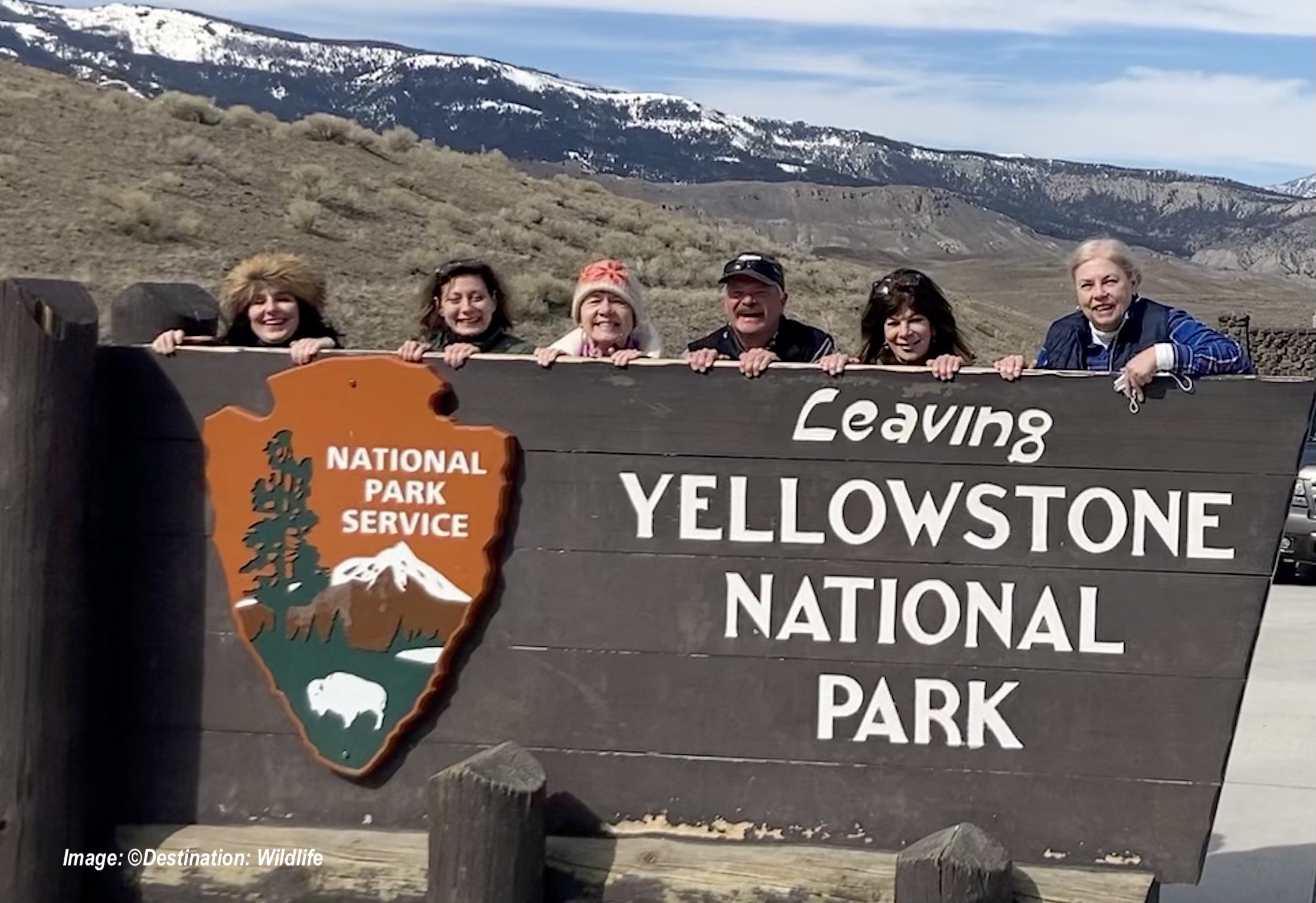
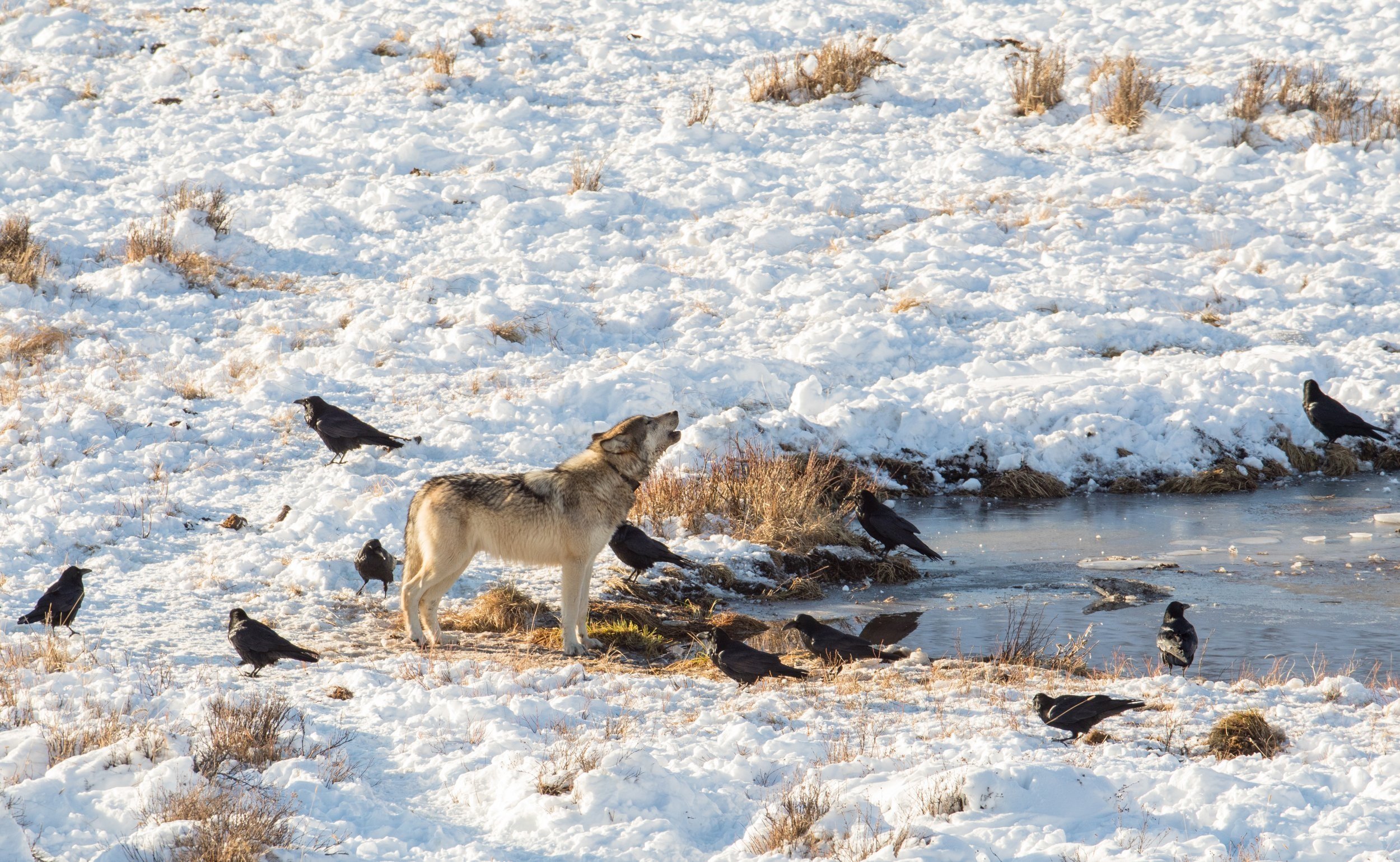
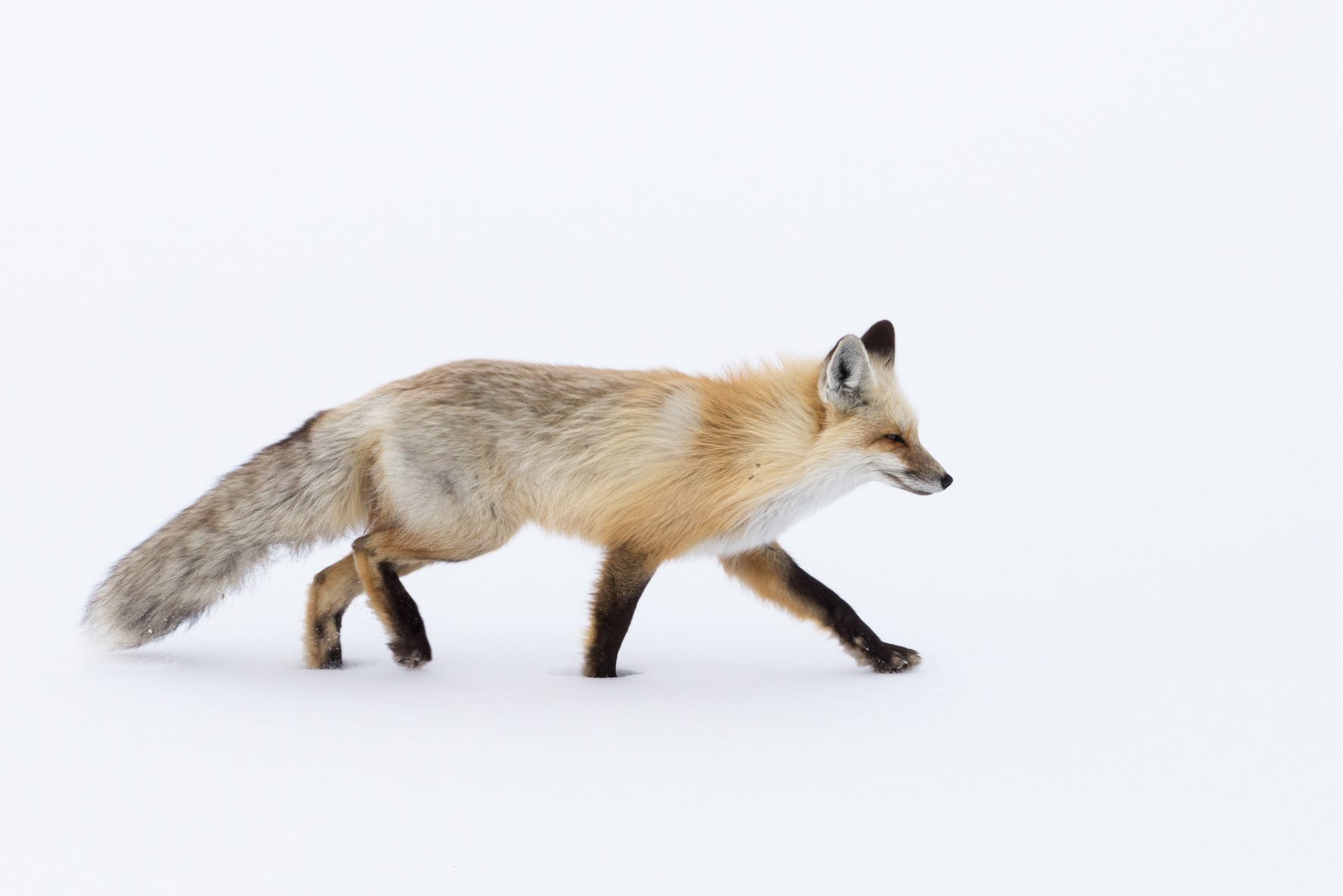
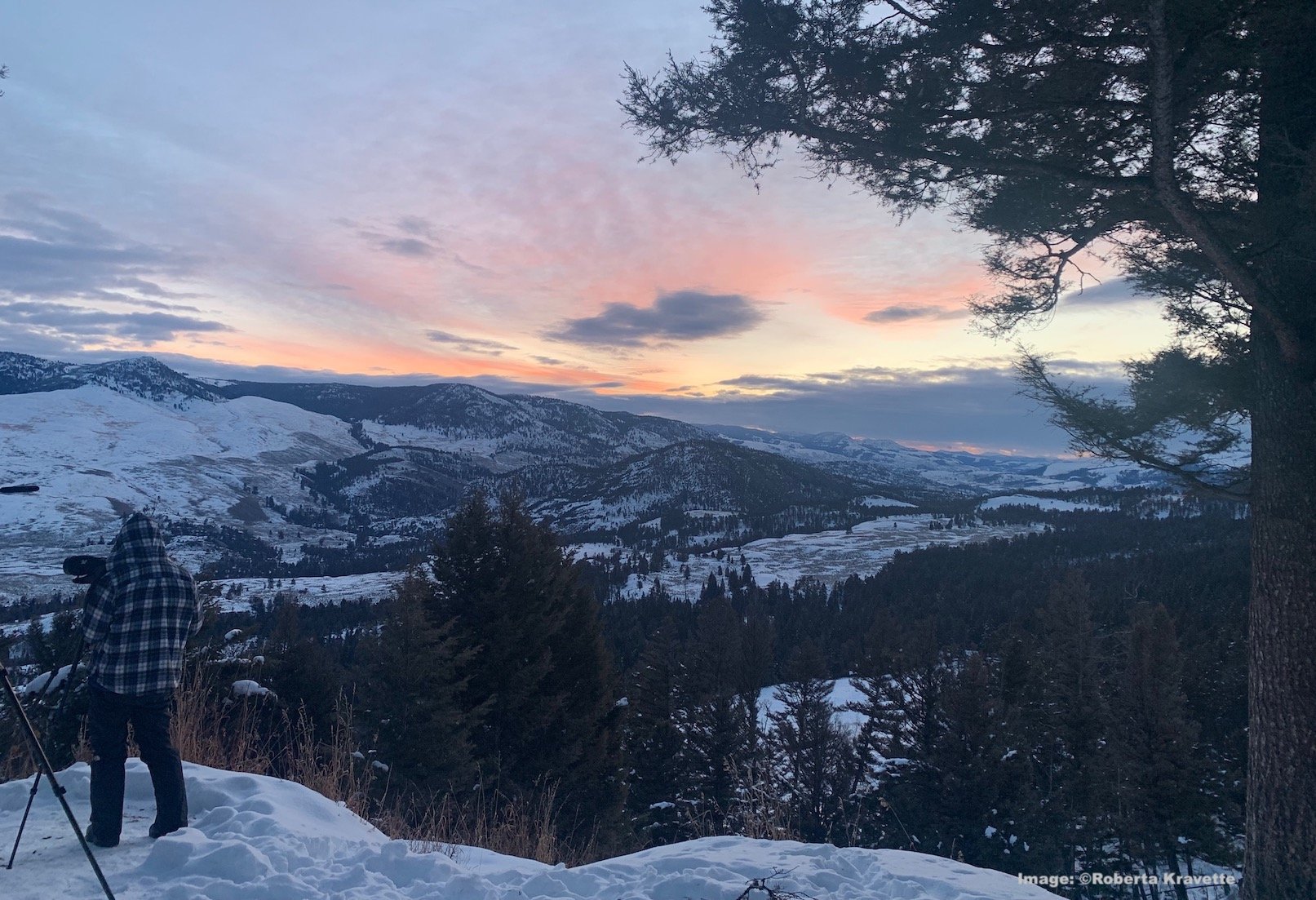
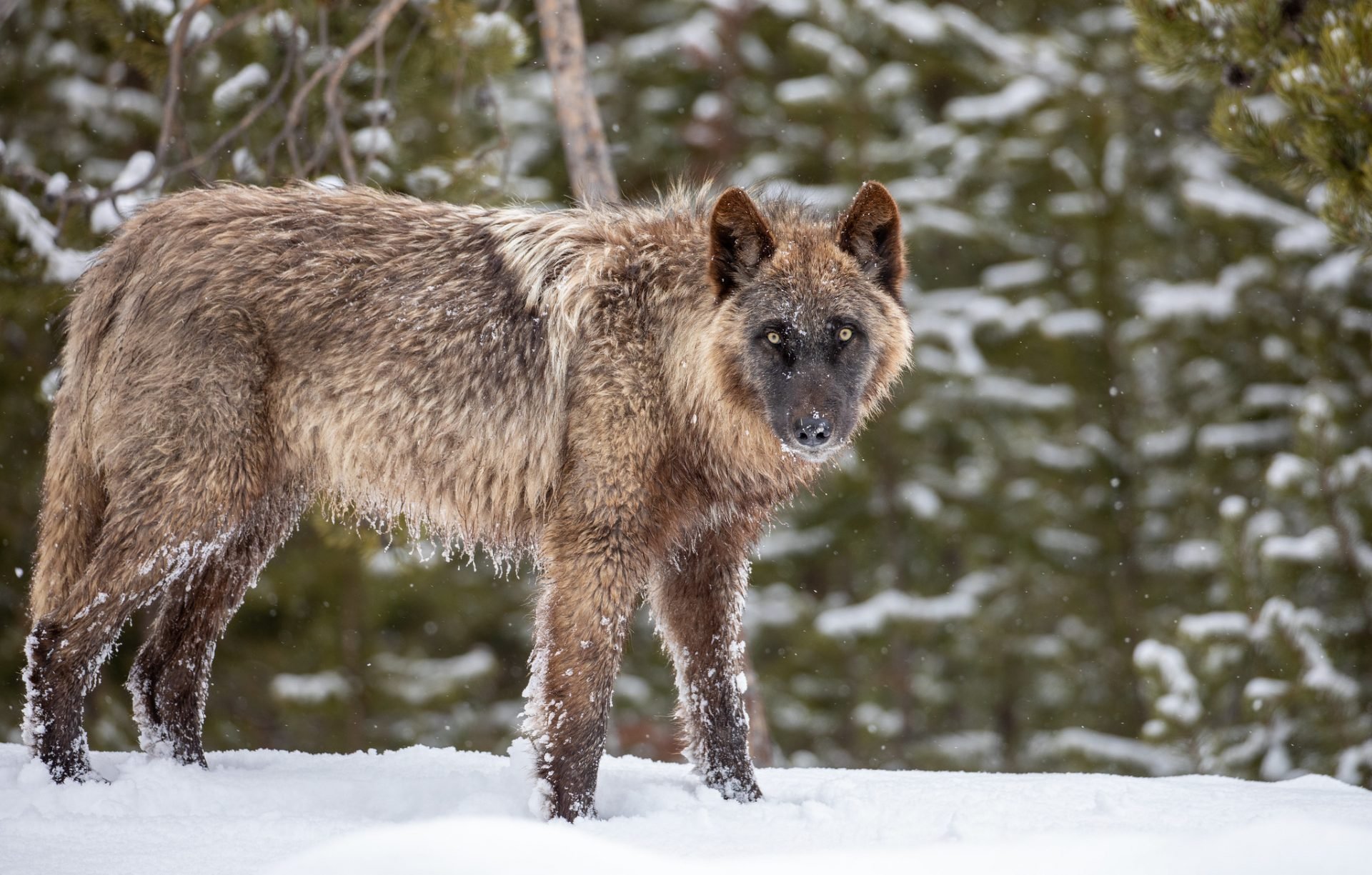
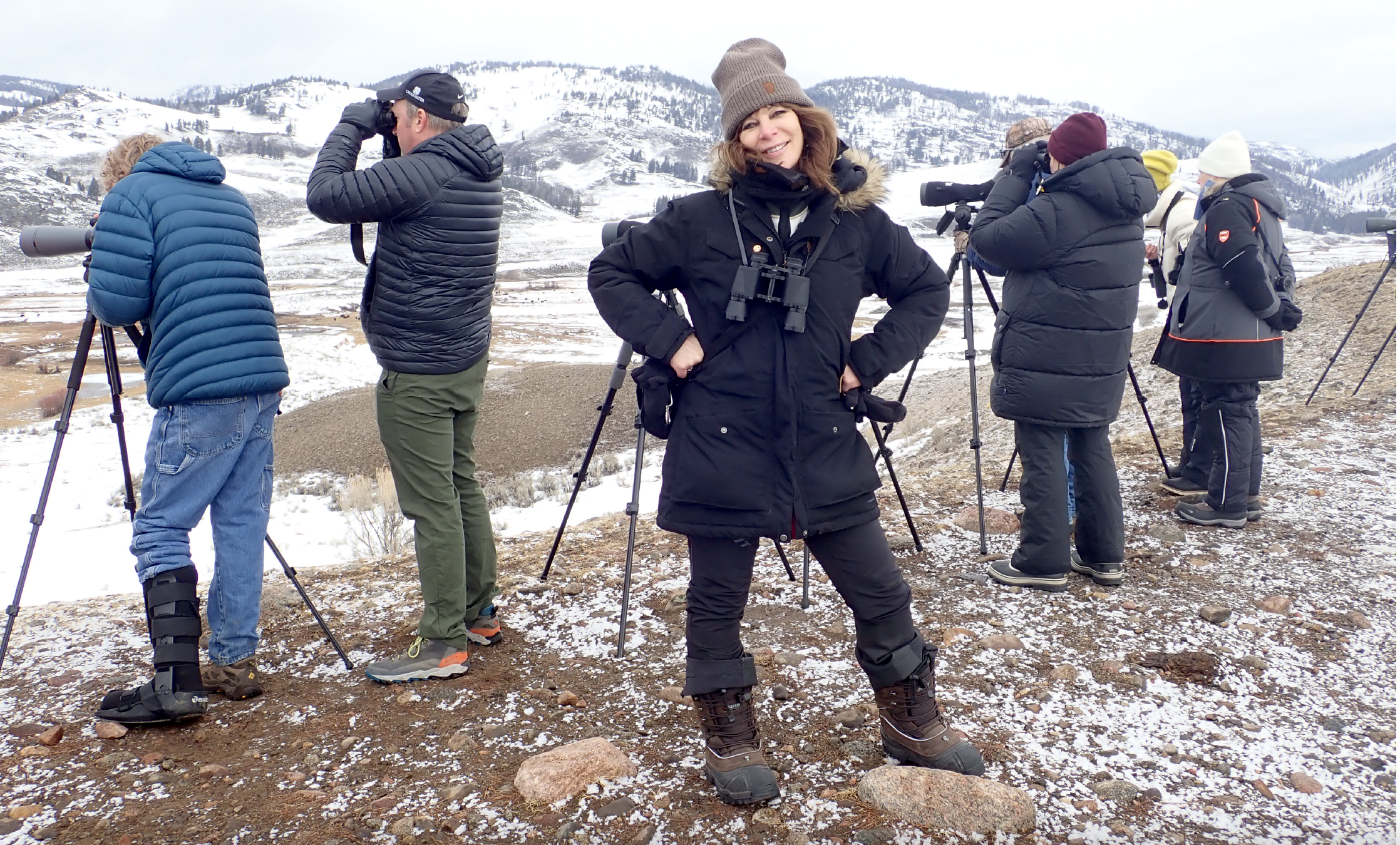
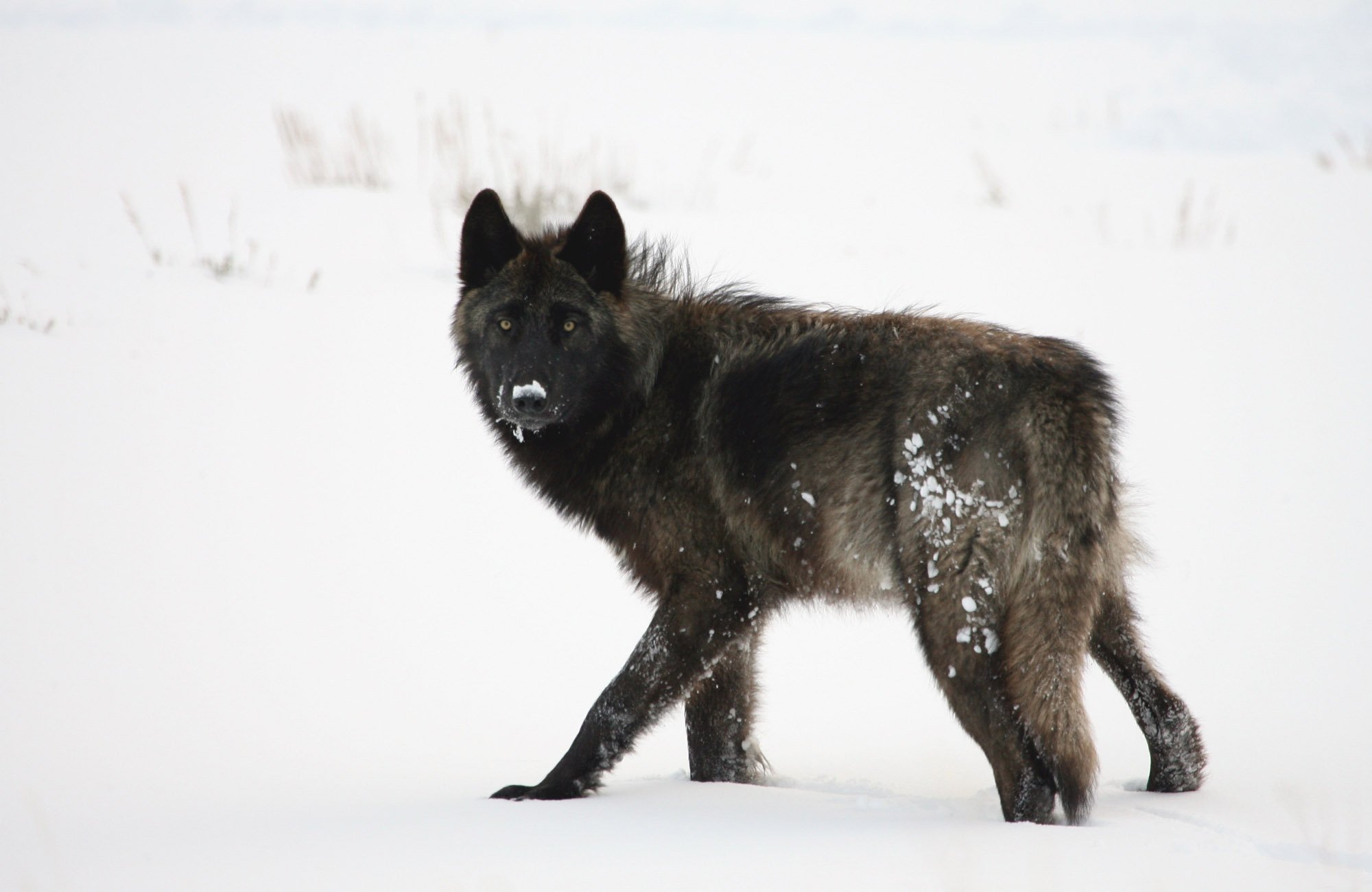
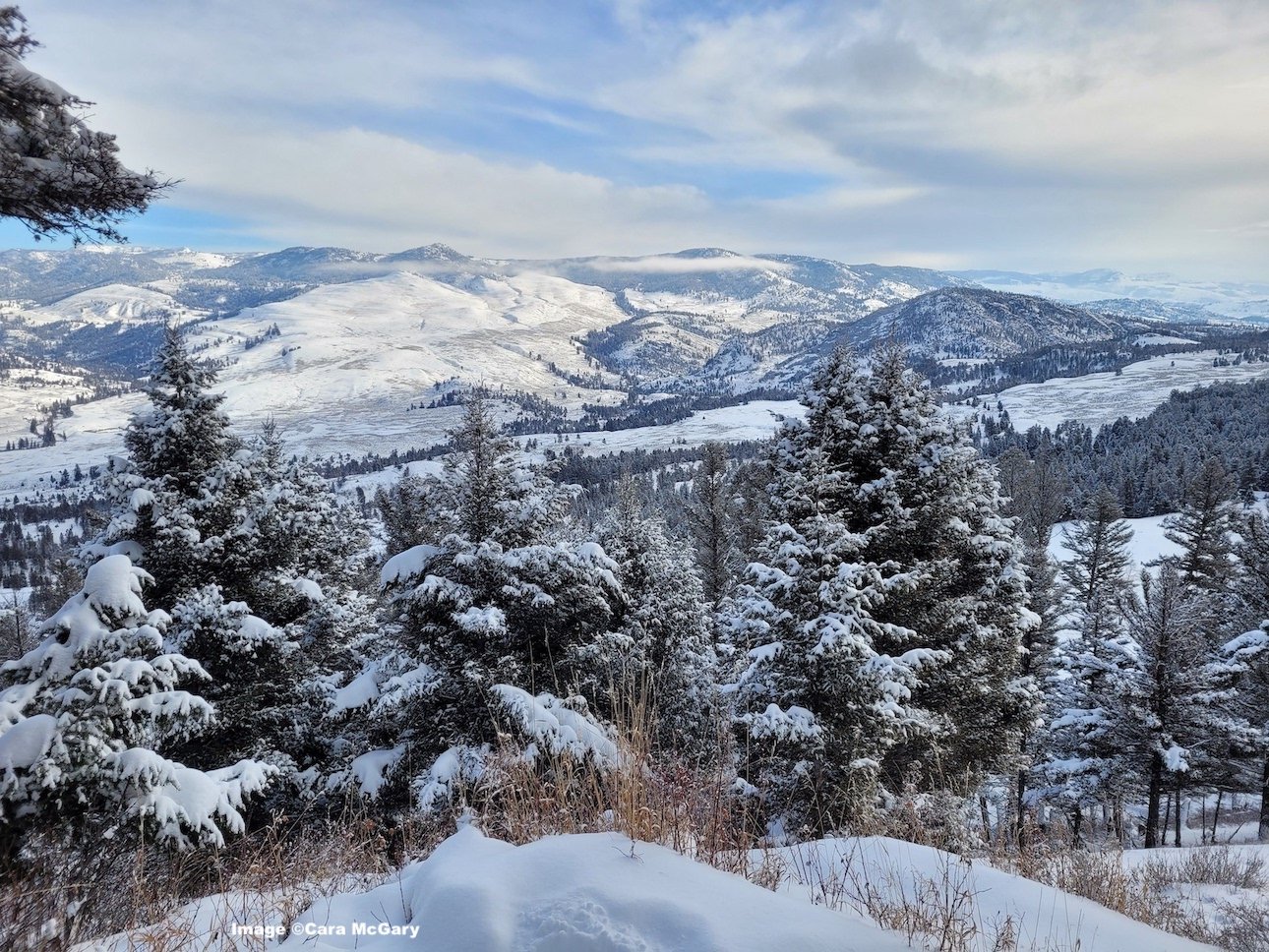
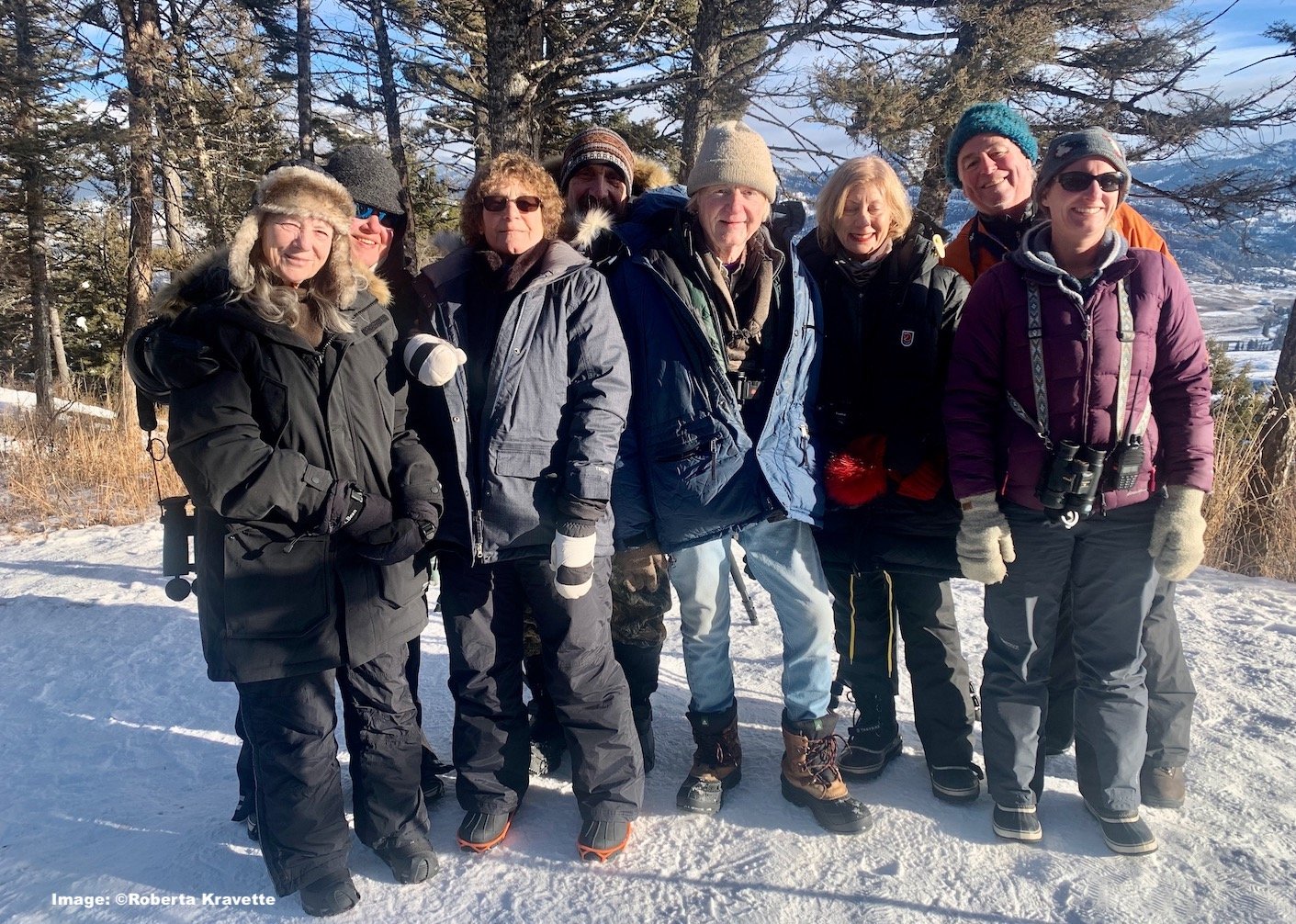
Detailed Itinerary
Detailed Itinerary
Day 1 February 22 / March 01
Welcome to Montana!
Arrival in Bozeman and overnight. We will have a welcome dinner together at a nearby establishment. Our cozy hotel is within walking distance of the town. If your flight arrives early, rest, swim, or enjoy a sauna at the lodge, or walk into town and explore! We will meet in the lobby at about 5:30 PM and head into Bozeman for a welcome dinner!
Included: Dinner
Wolf on the Northeast Entrance Road in Lamar Valley. Image courtesy of Yellowstone National Park.
Day 2: Feb. 23 / Mar. 02
Travel to Gardiner & Start Exploring Yellowstone
Our guide will pick us up in Bozeman and transfer us to Gardiner in the morning. After arriving in Gardiner, we will check into our accommodations at the Wonderland Cafe and Lodge and break for lunch at the cute cafe downstairs. This will serve as our base camp for the next three days.
In the afternoon, our guide will pick us up for the drive into Gardiner, Montana at the gate of Yellowstone National Park.We will enjoy a lunch picnic on the way, then check into our lodge and head into the park for a half-day exploration of the Mammoth Terraces. We will to freshen up and enjoy dinner at the lodge.
Included: Light continental-style breakfast at the hotel, picnic lunch, and dinner.
Day 3: Feb. 24 / Mar. 03
The Northern Range Wolf Watching
After an early pick up (depending on sunrise, 5:30 or 6am) we are off to the Northern Range, the hub of wildlife in Yellowstone National Park. Our guide will fill us in on recent as well as historic events in regard to Yellowstone wolves, their pack dynamics, litter size, and all things “wolf.”
Early morning at Yellowstone with world-renowned wildlife biologist and author, Diane Boyd and beloved wolf expert and author, Rick McIntyre. We never know who we will meet. Image. ©Roberta Kravette
They will also put us in the best locations to view the animals, interpret behavior, and set up spotting scopes. We will always keep our distance from wolves and bears at 100 yards or more. The premium spotting scopes allow us to view the animals in detail, even at significant distances. Our guide will be an experienced biologist and naturalist with excellent wildlife interpretation skills. We will have a tasty lunch at a cafe or in the field.
Short walks may occur throughout the day. After about seven hours of exploring, we will return to our lodge. In the evening, we will enjoy a private lecture by an expert in the field (to be announced later). Dinner together at the lodge and a good night’s sleep will round out the day’s activities.
Included: Light breakfast in the field, lunch in the field, dinner at the lodge
Day 4: Feb. 25 / Mar. 04
Wolf Watching & Learning
Our guide will pick us up at 5:30 or 6 am, depending on the sunrise. Early morning starts are essential for potentially awesome wildlife sightings. Today, we may drive further depending on recent and/or new sightings of our favorite animals.
Our wildlife tours are always dynamic and depend on wildlife movements and events. For example, we may be lucky and stumble on a fresh carcass. Or we may see some mating behavior, or the wolves, coyotes, foxes, eagles, ravens, and more that may come from afar to participate and fight for a meal.
Forensics expert Jim Halfpenny speaking to our group.
Image: ©Roberta Kravette
Short walks may occur throughout the day. After about seven hours of exploring, we will return to our lodge. In the evening, we will enjoy a private lecture by an expert in the field (to be announced later). Dinner together at the lodge and a good night’s sleep will round out the day’s activities.
Included: Light breakfast in the field, lunch in the field, dinner at the lodge
Day 5: Feb. 26 / Mar. 05
A Flexible Day
Depending on how successful we were on the previous days and the group's interests, we will have a choice of another exploratory safari or a small hike to one of various areas. Lunch in the field.
Short walks may occur throughout the day. After about seven hours of exploring, we will return to our lodge. In the afternoon, we will enjoy our final meeting with an expert in the field (to be announced later). Dinner together at the lodge and a good night’s sleep will round out the day’s activities.
Included: Light breakfast in the field, lunch in the field, dinner at the lodge
Day 6: Feb. 27 / Mar. 06
An Early Drive & Return to Bozeman
Today, we will offer a half-day with an early start. Depending on the interests and abilities of the group, this may be a birding trip, a search for an animal we have not yet seen, or something else.
After lunch in Gardiner, we will travel back to Bozeman to our cozy hotel and say good-by to our wonderful guide. This evening, we will celebrate our adventure with a farewell dinner at a nearby restaurant and a good night’s sleep.
Included: Breakfast at the lodge or in the field, TBD, lunch in Gardiner, farewell celebration dinner in Bozeman.
Day 7: Feb. 28 / Mar. 07
Homeward Bound
We will have a quick Continental breakfast at the hotel and transfer to the airport for flights home.
Wildlife
Wildlife
The wildlife hub of the Continental United States is Yellowstone National Park, and the northern area of the park, specifically the Lamar Valley, has the greatest concentration of wildlife in the park. This is where we will spend the majority of our time. And winter is a great time for observing wildlife in the park.
Many animals migrate from higher elevations to lower areas with less snow-pack and wind, allowing observers to see more wildlife closer to park roads and facilities. And the white landscape makes spotting wildlife easier because their dark silhouettes stand out against the snow. Perhaps best of all, there are far fewer crowds to contend with as compared to the summer months, providing a quieter, more natural experience.
Mammals
The Pine Martin. Is this the cutest carnivore in North America? Photo courtesy the National Park Service.
Yellowstone National Park and the Greater Yellowstone Ecosystem have the greatest concentration of mammals in the Lower 48. In addition to the absolute numbers, Yellowstone is known for its biodiversity, with 67 known mammal species calling the park home.
Amongst the mammals in the park are many different types of rodents, including several squirrel species, chipmunks, marmots, and beavers. Hares, rabbits, and pikas also live throughout the park. There are seven naturally occurring large ungulates in the park. Bison are the most iconic, but bighorn sheep, moose, pronghorn, elk, mule deer, and white-tailed deer also call the park “home.” Mountain goats are not native to Yellowstone but have colonized parts of the park.
There are also numerous carnivores, including three cats (cougars, bobcats, and Canadian lynx), three canids (gray wolves, coyotes, and red foxes), and two types of bears (brown or grizzly bears & black bears). In addition, there are wolverines, badgers, river otters, long and short-tailed weasels, and martins. Please note: We will (most likely) not see bears as they hibernate at this time)
Wolf pack at play. Image: ©Doug Smith. Courtesy National Park Service.
A special note on wolves: From 1995 to 1997, 41 wild wolves from Canada and northwest Montana were released in Yellowstone. All of the wolves currently in the Greater Yellowstone Ecosystem descend from these 41 original wolves. As of January 2023, there are at least 108 wolves in the park. Ten packs were noted. Wolves in Yellowstone sit at the core of a larger population connected throughout the Greater Yellowstone Ecosystem. The wolf population has fluctuated between 83 and 123 wolves since 2009.
Yellowstone is home to the world’s longest-running wild wolf study. Much of the research happens during the winter when the park is mostly closed, and there are few visitors. Exactly when we will be visiting!
Want to know more about Yellowstone’s wolves? See Q&A videos with Doug Smith hosted on the Yellowstone National Park page. Doug Smith is the project leader for the Wolf Restoration Project in Yellowstone and has been with the program since its inception. Doug has studied wolves for over 20 years. Prior to Yellowstone, he worked with wolves in Michigan (Isle Royale National Park) and Minnesota.
Birds
Bald Eagle enjoying breakfast. Image: ©Jim Peaco. Courtesy National Park Service.
Records of bird sightings have been kept in Yellowstone since the park was established in 1872. Nearly 300 species of birds have been documented, including raptors, songbirds, shorebirds, and waterfowl. According to the National Park Service, approximately 150 species nest in the park. A wide variety of habitat types and a range fo elevations found within Yellowstone contribute to the relatively high diversity of bird species.
In the winter, raptors are the birds most easily seen. Sightings of bald eagles and golden eagles are common. Northern harriers, red-tailed hawks, rough-legged hawks, northern goshawks, Cooper’s hawks, and sharp-shinned hawks are also winter inhabitants, but less commonly sighted. You may catch sight of an American kestrel or a prairie falcon, too. Great horned owls, northern pygmy owls, great grey owls, boreal owls, and northern saw-whet owls make Yellowstone home in the winter.
Magpies and ravens will be common around wolf kills. Look for trumpeter swans along waterways, and keep an eye out for the American dipper, also known as the water ousel. This robin-sized bird repeatedly walks along the bottoms of the frigid and fast-flowing streams looking for choice water insects hidden beneath the stream's pebbles. Likely sightings also include Barrow’s goldeneye, lesser scaup, Clark’s nutcracker, mountain chickadee, the red-breasted nuthatch, and the rosy finch. Woodpeckers, especially, hairy woodpeckers, can also be seen. Last but not least, keep an eye out for gray jays, not only for the sighting but they are not known as "camp robber barons" for nothing.
You can find a complete Yellowstone birding checklist on the NPS website.
Others
Yellowstone cutthroat trout—native to Yellowstone—are a keystone species that many species of birds and mammals rely on as an energy source. Image: ©Jay Fleming. Courtesy National Park Service.
Fish: Yellowstone has 11 species of native fish and 5 introduced species. Although we are unlikely to see many in the winter, Yellowstone and westslope cutthroat trout are the most icon of these species/
Amphibeans: There are five species of amphibians in the park: these are Western tiger salamander, boreal chorus frog, Western toad, Columbia spotted frog, and plains spadefoot toad. To survive the winter, some Yellowstone amphibians go into water that does not freeze (spotted frogs), others enter underground burrows (salamanders and toads), and others (boreal chorus frog) tolerate freezing and go into a heartstopped dormancy for the winter in leaf litter or under woody debris.
Reptiles: Reptiles are less studied than amphibians in Yellowstone. There are 6 confirmed species: bullsnake, prairie rattlesnake, rubber boa, sagebrush lizard, common garter snake, and terrestrial garter snake. We are very unlikely to see reptiles during the winter.
Accommodations
Accommodations
At Destination: Wildlife, we strive to apply the principles of conservation tourism - travel that supports wildlife, habitats, and local communities. This implies a commitment to ensure your tourism dollars stay local, creating jobs and improving the livelihoods of those that live there. We use locally owned and operated accommodations, restaurants, and other providers for these reasons. But this commitment also ensures you receive the personal touch only a small business can provide while giving you a more authentic experience.
Bozeman
We will stay at the Lews & Clark Hotel on our first and last nights—a second-generation, locally-owned establishment with deep roots in the community and easy access to the airport.
The rooms are comfortable, the atmosphere welcoming. Located on the edge of historic downtown Bozeman, it is within walking distance to shops, restaurants, and galleries.
Bring a bathing suite and enjoy their sauna or pool! Tea and coffee is available 24/7. Continental breakfast included.
Gardiner
While in Yellowstone, we will stay at the Wonderland Cafe and Lodge in the heart of Gardiner at the North Entrance to Yellowstone NP.
Rooms are studios or large shared suites. Each Guest will have their own bedroom and bath - some guests will share a kitchen (sink, stove, microwave, refrigerator) and sitting area.
NOTE: The lodge area can only be accessed by an outside stairway.
The Wonderland Café and Lodge is owned and run by a local mother.
Tour Information
Tour Information
Yellowstone gray wolf making its way through the snow. Image: ©Frank W. Jacob. Courtesy National Park Service.
Dates
Week 1 Tour: February 22-28
Week 2 Tour: March 01-07
Price
$6299.99pp ex flights. *There is a single-room supplement of $307.00 in Bozeman that covers the arrival night and the night before departure.
*Please note: Single rooms are applicable in Bozeman only; our stay at the Wonderland Lodge will be in large suites.
In Gardiner, solo travelers will have a private bedroom and private baths in a suite with a shared kitchen and living room.
Couples may have a private suite or a shared suite with a private bedroom and bath.
A $500 donation to the Wolf Conservation Center is included in the price of the tour, and this donation is tax-deductible for US residents.
Group Size
Limited to 6 Guests. The group size on this tour is limited to 6 guests plus a tour leader and a guide. An important aspect of responsible tourism is maintaining a limited group size, and wildlife is always best experienced in smaller groups. Our small group size is less likely to influence wildlife behavior, allowing each of us to enjoy more meaningful interactions with our wildlife guide and guest speakers, and providing us with more flexibility in our daily itinerary decisions.
Included
► Tour Price Includes: Accommodations, services of a trip leader and professional wildlife guide, wolf and wildlife viewing excursions, evening presentations on wolf biology and behavior or other subjects pertaining to Yellowstone, wolves or wildlife, all meals from dinner on Day 1 through breakfast on the final day, snacks during the excursions, airport transfers on the first and final days, and transfers between Bozeman and Gardiner.
► Donation: A $500 donation to the Wolf Conservation Center is included in the price of the tour, and this donation is tax-deductible for US residents.
Not Included
Travel to and from Bozeman, Montana, alcoholic beverages, gratuities, * park entry fees, items of a personal nature (phone calls, laundry, and internet, etc.), airline baggage fees, airport and departure taxes (if any), travel insurance protection, and medical evacuation insurance.
Please note that the National Park Service does not allow registered park guides to purchase passes to Yellowstone National Park for their clients. We will have to purchase passes.
If you already have a National Park Pass, please bring it. That is all you need, but you must remember to bring it.
Under 62-yo? If you DO NOT have a National Park pass, the most economical passes at this time are annual passes, which cost about $80 in 2023.
Over 62-yo? For those over 62, you can purchase a lifetime pass for the same amount. If you have one, please bring it.
Breakfast is served! Coyotes dine on a wolf kill while ravens wait their turn. Image: ©Roberta Kravette
Physical Requirements
Easy. This wolf-watching tour with Destination: Wildlife requires very little walking. Travelers must be able to walk up/down two flights of stairs because there are no elevators at the Wonderland Lodge in Gardiner.
Excursions are generally on smooth roads but involve several hours of intermittent vehicle travel daily. There will be short walks on icy road-sides or paths. Guests should have normal balance and be able to walk unaided. Guests must be prepared for below-freezing temperatures and slippery surfaces.
Meals
Please Note: Dining options in Gardiner are severely limited. Most dinner restaurants in Gardiner are closed at this time of year. We will NOT use the vehicle after dark due to unpredictable weather, wildlife habits, and other considerations. All of our dinners in Gardiner will be taken at the Wonderland Cafe. The selections are limited but freshly prepared.
Most dietary restrictions (plant-based diets, gluten-free, etc.) can be more easily accommodated at the Wonderland Cafe because our host practices farm-to-table and hand-crafted cuisine. However, our dining options are also relatively limited in Bozeman; please let us know as soon as possible of any dietary requirements due to serious medical conditions or strict personal restrictions.
Need to Know
Yellowstone in February and March is cold. Temperatures range from zero to 20°F (-18°C to -7°C) throughout the day. Sub-zero temperatures are common, especially during the early morning when we begin our wolf-watching excursion and at higher elevations. The record low temperature is -66°F (-54°C). Wind chills well below zero should be expected, and you will be stationary most of the time outside the vehicle. Appropriate clothing is paramount.
Please look at the suggested packing list and contact us with any questions.
Regarding Wolves: Wolves are in Yellowstone year-round, but the mid-winter months are known for the quantity and quality of wolf sightings, especially in the Lamar Valley. During the winter, less foliage and the white snow make it easier to see the wolves, and the cold weather drives their prey into the valleys, where they, too, are more easily sighted. In addition, the wolf packs living in the Lamar Valley have become accustomed to humans along the roads, and are less likely to hide. This combination makes sightings of wolves in this area common during the winter. BUT conditions vary, and wolves here live wild and free: we do not guarantee that you will see wolves or any other wildlife, nor can we promise exactly what your experience will be.
Early Mornings: The best time for wolf sightings is usually around and slightly after first light. That means we must depart as early as 5AM depending on the time of dawn and sunrise. If you miss the daily start time, you will be left at the lodge for the day, we will not hold the rest of the group.
Getting There and Back
Please schedule your flights to arrive by 3 pm to allow time for delays and to be able to attend the orientation dinner on Day 1 of the tour. You are free to depart at any time on the final day. If you would like to arrive a day early (Day 0) please let us know in advance. If you would like Destination: WIldlife to book your flights, please let us know. There is a $125.00 one-time booking fee. No extra charge if we need to make changes
Cancellation Policy
Due to the nature of our tours, no refunds are available once a tour has started or for any package, accommodation, meals, or other services included. We understand that sometimes, even the most eagerly anticipated plans may need to be canceled. Please see below for our cancellation policy. We strongly recommend that every traveler purchase travel insurance.
Cancellation: More than 120 Days
Forfeiture of 20% of trip fees, including extensions, plus any specified donations to the sponsor, any non-refundable train/airfare, and a $150 cancellation processing fee.*
Cancellation 120 to 90 Days
Forfeiture of 30% of trip fees, including extensions, plus any specified donations to the sponsor, any non-refundable train/airfare or other, and a $150 cancellation processing fee.*
Cancellation 90 to 61 Days
Forfeiture of 50% of trip fees, including extensions, plus any specified donations to the sponsor, any non-refundable train/airfare or other, and a $150 cancellation processing fee.*
Cancellation 60 Days or Less
Forfeiture of 100% of trip fees, including extensions, plus any specified donations to the sponsor, any non-refundable train/airfare or other, and a $150 cancellation processing fee.*
*Where another guest fills the space, a portion of your fees may be eligible for an additional partial refund, subject to Destination: Wildlife's sole and exclusive discretion.
Travel, Medical and Evacuation Insurance
Travel Insurance: We strongly suggest travel insurance to protect you from travel delays, cancellations, luggage, medical, or other unexpected occurrences. There are many good travel insurance providers. We have worked with Allianz for many years and recommend them as cost-effective, comprehensive, and fair.
They have multiple policy choices and will cover couples or families traveling together under one plan. We are happy to provide a comparison of their policies for you. Just ask.
Evacuation Insurance: This is NOT travel insurance. Evacuation insurance will evacuate you in case of medical or other emergency. It is a membership plan that covers you for a year or more regardless of the location of the emergency, from your backyard to the Himalayas.
Black wolf in the Lamar Valley. Image: ©Jim Peaco. Courtesy National Park Service.
Making a Difference
How Your Trip Makes A Difference
Wolf Conservation Center
Our mission is to advance the survival of wolves by inspiring a global community through education, advocacy, research, and recovery
The Wolf Conservation Center in South Salem, New York is committed to teaching people about wolves, their relationship to the environment, and the human role in protecting their future.
Founded by Hélène Grimaud in 1999, the Wolf Conservation Center (WCC) is a 501(c)(3) not-for-profit environmental education organization working to protect and preserve wolves in North America through science-based education, advocacy, and participation in the federal recovery and release programs for two critically endangered wolf species - the Mexican gray wolf and red wolf.
The WCC's three 'ambassador wolves' reside on exhibit where they help teach the public about wolves and their vital role in the environment. Through wolves, the WCC teaches the broader message of conservation, ecological balance, and personal responsibility for improved human stewardship of our World.
Go to nywolf.org to learn more about this wonderful organization.
Greater Yellowstone & Wolves
Two wolf brothers share a yawn. Image courtesy Wolf Conservation Center
Your tourism dollars help ensure the future of Yellowstone’s wolves, flowing to local communities living in and around the greater Yellowstone ecosystem, creating jobs, and improving livelihoods. Your presence becomes a powerful incentive for these communities to protect their natural resources, including the wolf. A recent study concluded that wolf-watching in Yellowstone National Park generates upwards of $35 million in tourism revenue annually for businesses in Montana, Wyoming, and Idaho. By practicing responsible conservation tourism, we ensure that our dollars stay local and help support families and individuals even after we leave.
When it pays it stays. We practice wolf conservation by making wolves worth more alive than as a trophy or political statement, and this tour makes you part of that effort.
Magpies are very talented thieves - quick, smart, and they can fly. What is a wolf to do? A wolf chasing magpies off a kill. Image: ©Jim Paeco Courtesy National Park Service.
Reviews
Guest Reviews
Reviews for Destination: Wildlife
Doug, Utah
Winter Wolf Watching and Learning, 2023
Thanks for a wonderful trip. I thoroughly enjoyed interacting with everyone involved. It was the best trip of its kind that I have attended. All in all, it was a grand time, and I look forward to another adventure with you. I really like the learning mixed with the photography. Thanks for a wonderful trip. I thoroughly enjoyed interacting with everyone involved. It was the best trip of its kind that I have attended…Exceeded my expectations.
Penny, New York
Winter Wolf Watching and Learning, 2023
My favorite part of the trip was meeting and listening to the speakers and Rick McIntyre. Cara [our guide] met and exceeded expectations. I didn’t really have any but it sure was exciting. The lectures were awesome. I can’t think of anything to change.
Amy, New York
Winter Wolf Watching and Learning, 2023
An absolute 10!!! This trip was a total home run and delivered on wolves and wildlife well above my hopes and expectations. The lectures were outstanding and extremely informative and each of the lecturers captured and held my attention throughout. Cara McGary [our guide] was an absolute gem--the depth of her knowledge and experience, as well as her personality, elevated the experience, and you did an excellent job in seeing that all arrangements, meals, etc., ran timely, that accommodations were comfortable, etc. Looking forward to future trips-- and definitely Namibia.
Noreen, New York
Exploring Women’s Winter Wolf Trek, 2022
The trip was fabulous and couldn't have been much better. …I was impressed that you did a Zoom call rather than just sending a gear list - it is an example of how much personal attention you devoted to us.
Jeannie, New York
Exploring Women’s Winter Wolf Trek, 2022
So many favorites! If I have to answer one, it was watching intense interactions between Bison and Wolves on two occasions.
Another favorite was observing wildlife in the field in combination with meetings with experts who did the deep dive with us into scientific and behavior research. Including running into other experts sporadically on our daily forays, who were extremely gracious in sharing not only research but stories that made one’s eyes open wide with amazement,
Another favorite was the history of Wolf #1228 and actually seeing her several times. Particularly when suddenly she stuck her head over a hill with a Golden Eagle a few feet next to her. Both wolf & eagle were intensely peering over the hilltop, observing two coyotes finishing a meal on a young elk (which 1228 likely killed earlier).
Added to all that were two dozen ravens meandering around near the coyotes, awaiting their turn for scraps. Topped off by an occasional not-too-serious coyote charge if they got too close. A random hop-hop-hop dance by the ravens added to the whirl of activity.
Wow!
Are you dreaming about a wolves? Join us! Image ©Karel Bock

